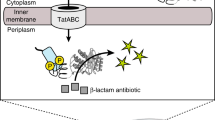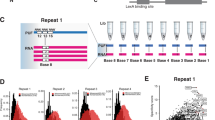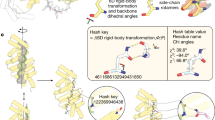Abstract
We report here the evolution of ankyrin repeat (AR) proteins in vitro for specific, high-affinity target binding. Using a consensus design strategy, we generated combinatorial libraries of AR proteins of varying repeat numbers with diversified binding surfaces. Libraries of two and three repeats, flanked by 'capping repeats,' were used in ribosome-display selections against maltose binding protein (MBP) and two eukaryotic kinases. We rapidly enriched target-specific binders with affinities in the low nanomolar range and determined the crystal structure of one of the selected AR proteins in complex with MBP at 2.3 Å resolution. The interaction relies on the randomized positions of the designed AR protein and is comparable to natural, heterodimeric protein-protein interactions. Thus, our AR protein libraries are valuable sources for binding molecules and, because of the very favorable biophysical properties of the designed AR proteins, an attractive alternative to antibody libraries.
This is a preview of subscription content, access via your institution
Access options
Subscribe to this journal
Receive 12 print issues and online access
$209.00 per year
only $17.42 per issue
Buy this article
- Purchase on Springer Link
- Instant access to full article PDF
Prices may be subject to local taxes which are calculated during checkout





Similar content being viewed by others
References
Groves, M.R. & Barford, D. Topological characteristics of helical repeat proteins. Curr. Opin. Struct. Biol. 9, 383–389 (1999).
Andrade, M.A., Perez-Iratxeta, C. & Ponting, C.P. Protein repeats: structures, functions, and evolution. J. Struct. Biol. 134, 117–131 (2001).
Kobe, B. & Kajava, A.V. When protein folding is simplified to protein coiling: the continuum of solenoid protein structures. Trends Biochem. Sci. 25, 509–515 (2000).
Marcotte, E.M., Pellegrini, M., Yeates, T.O. & Eisenberg, D. A census of protein repeats. J. Mol. Biol. 293, 151–160 (1999).
Ellis, J., Dodds, P. & Pryor, T. Structure, function and evolution of plant disease resistance genes. Curr. Opin. Plant Biol. 3, 278–284 (2000).
Bork, P. Hundreds of ankyrin-like repeats in functionally diverse proteins: mobile modules that cross phyla horizontally? Proteins: Struct. Funct. Genet. 17, 363–374 (1993).
Sedgwick, S.G. & Smerdon, S.J. The ankyrin repeat: a diversity of interactions on a common structural framework. Trends Biochem. Sci. 24, 311–316 (1999).
Suzuki, F. et al. Functional interactions of transcription factor human GA-binding protein subunits. J. Biol. Chem. 273, 29302–29308 (1998).
Malek, S., Huxford, T. & Ghosh, G. IκBα functions through direct contacts with the nuclear localization signals and the DNA binding sequences of NF-κB. J. Biol. Chem. 273, 25427–25435 (1998).
Winter, G. & Milstein, C. Man-made antibodies. Nature 349, 293–299 (1991).
Plückthun, A. et al. in Antibody Engineering (eds. McCafferty, J., Hoogenboom, H.J. & Chiswell, D.J.) 203–252 (IRL Press, Oxford, 1996).
Nygren, P.-Å. & Uhlén, M. Scaffolds for engineering novel binding sites in proteins. Curr. Opin. Struct. Biol. 7, 463–469 (1997).
Skerra, A. Engineered protein scaffolds for molecular recognition. J. Mol. Recognit. 13, 167–187 (2000).
Skerra, A. Imitating the humoral immune response. Curr. Opin. Chem. Biol. 7, 683–693 (2003).
Forrer, P., Stumpp, M.T., Binz, H.K. & Plückthun, A. A novel strategy to design binding molecules harnessing the modular nature of repeat proteins. FEBS Lett. 539, 2–6 (2003).
Binz, H.K., Stumpp, M.T., Forrer, P., Amstutz, P. & Plückthun, A. Designing repeat proteins: well-expressed, soluble and stable proteins from combinatorial libraries of consensus ankyrin repeat proteins. J. Mol. Biol. 332, 489–503 (2003).
Kohl, A. et al. Designed to be stable: crystal structure of a consensus ankyrin repeat protein. Proc. Natl. Acad. Sci. USA 100, 1700–1705 (2003).
Mosavi, L.K., Minor, D.L. Jr. & Peng, Z.-y. Consensus-derived structural determinants of the ankyrin repeat motif. Proc. Natl. Acad. Sci. USA 99, 16029–16034 (2002).
Main, E.R., Xiong, Y., Cocco, M.J., D'Andrea, L. & Regan, L. Design of stable alpha-helical arrays from an idealized TPR motif. Structure (Camb) 11, 497–508 (2003).
Rubin, S.M., Lee, S.Y., Ruiz, E.J., Pines, A. & Wemmer, D.E. Detection and characterization of xenon-binding sites in proteins by 129Xe NMR spectroscopy. J. Mol. Biol. 322, 425–440 (2002).
Hanes, J. & Plückthun, A. In vitro selection and evolution of functional proteins by using ribosome display. Proc. Natl. Acad. Sci. USA 94, 4937–4942 (1997).
Yang, F. et al. Novel fold and capsid-binding properties of the lambda-phage display platform protein gpD. Nat. Struct. Biol. 7, 230–237 (2000).
Hon, W.C. et al. Structure of an enzyme required for aminoglycoside antibiotic resistance reveals homology to eukaryotic protein kinases. Cell 89, 887–895 (1997).
Forrer, P., Tamaskovic, R. & Jaussi, R. Enzyme-linked immunosorbent assay for the measurement of JNK, ERK and p38 kinase activities. Biol. Chem. 379, 1101–1111 (1998).
Jones, S. & Thornton, J.M. Principles of protein-protein interactions. Proc. Natl. Acad. Sci. USA 93, 13–20 (1996).
Lo Conte, L., Chothia, C. & Janin, J. The atomic structure of protein-protein recognition sites. J. Mol. Biol. 285, 2177–2198 (1999).
Högbom, M., Eklund, M., Nygren, P.-Å. & Nordlund, P. Structural basis for recognition by an in vitro evolved affibody. Proc. Natl. Acad. Sci. USA 100, 3191–3196 (2003).
Eklund, M., Axelsson, L., Uhlén, M. & Nygren, P.-Å. Anti-idiotypic protein domains selected from protein A-based affibody libraries. Proteins: Struct. Funct. Genet. 48, 454–462 (2002).
Wahlberg, E. et al. An affibody in complex with a target protein: structure and coupled folding. Proc. Natl. Acad. Sci. USA 100, 3185–3190 (2003).
Hanes, J., Schaffitzel, C., Knappik, A. & Plückthun, A. Picomolar affinity antibodies from a fully synthetic naive library selected and evolved by ribosome display. Nat. Biotechnol. 18, 1287–1292 (2000).
Wodak, S.J. & Janin, J. Structural basis of macromolecular recognition. Adv. Protein Chem. 61, 9–73 (2002).
Jermutus, L., Honegger, A., Schwesinger, F., Hanes, J. & Plückthun, A. Tailoring in vitro evolution for protein affinity or stability. Proc. Natl. Acad. Sci. USA 98, 75–80 (2001).
Mian, I.S., Bradwell, A.R. & Olson, A.J. Structure, function and properties of antibody binding sites. J. Mol. Biol. 217, 133–151 (1991).
Jeffrey, P.D., Tong, L. & Pavletich, N.P. Structural basis of inhibition of CDK-cyclin complexes by INK4 inhibitors. Genes Dev. 14, 3115–3125 (2000).
Sundberg, E.J. & Mariuzza, R.A. Molecular recognition in antibody-antigen complexes. Adv. Protein Chem. 61, 119–160 (2002).
James, L.C., Roversi, P. & Tawfik, D.S. Antibody multispecificity mediated by conformational diversity. Science 299, 1362–1367 (2003).
Xu, L. et al. Directed evolution of high-affinity antibody mimics using mRNA display. Chem. Biol. 9, 933–942 (2002).
Zeytun, A., Jeromin, A., Scalettar, B.A., Waldo, G.S. & Bradbury, A.R. Fluorobodies combine GFP fluorescence with the binding characteristics of antibodies. Nat. Biotechnol. 21, 1473–1479 (2003).
Cattaneo, A. & Biocca, S. The selection of intracellular antibodies. Trends Biotechnol. 17, 115–121 (1999).
Ostermeier, C., Iwata, S., Ludwig, B. & Michel, H. Fv fragment-mediated crystallization of the membrane protein bacterial cytochrome c oxidase. Nat. Struct. Biol. 2, 842–846 (1995).
Sambrook, J., Fritsch, E.F. & Maniatis, T. Molecular cloning: A laboratory manual, edn. 2 (Cold Spring Harbor Press, New York, 1989).
Myszka, D.G. & Morton, T.A. CLAMP: a biosensor kinetic data analysis program. Trends Biochem. Sci. 23, 149–150 (1998).
Collaborative Computational Project, Number 4. The CCP4 Suite: Programs for Protein Crystallography. Acta Crystallogr. D 50, 760–763 (1994).
Navaza, J. Acta Crystallogr. A 50, 157–163 (1994).
Brünger, A.T. et al. Crystallography & NMR system: A new software suite for macromolecular structure determination. Acta Crystallogr. D 54, 905–921 (1998).
Jones, T.A., Zou, J.Y., Cowan, S.W. & Kjeldgaard, M. Improved methods for building protein models in electron density maps and the location of errors in these models. Acta Crystallogr. A 47, 110–119 (1991).
McDonald, I.K. & Thornton, J.M. Satisfying hydrogen bonding potential in proteins. J. Mol. Biol. 238, 777–793 (1994).
Wallace, A.C., Laskowski, R.A. & Thornton, J.M. LIGPLOT: a program to generate schematic diagrams of protein-ligand interactions. Protein Eng. 8, 127–134 (1995).
Koradi, R., Billeter, M. & Wüthrich, K. MOLMOL: a program for display and analysis of macromolecular structures. J. Mol. Graph. 14, 51–55 (1996).
Nicholls, A., Sharp, K.A. & Honig, B. Protein folding and association: insights from the interfacial and thermodynamic properties of hydrocarbons. Proteins: Struct. Funct. Genet. 11, 281–296 (1991).
Acknowledgements
We thank the members of the Plückthun and Grütter laboratories for valuable discussions and David L. Zechel for the critical reading of the manuscript. H.K.B. was supported by a pre-doctoral fellowship of the Roche Research Foundation. M.T.S. was in receipt of a pre-doctoral scholarship from the Fonds der Chemischen Industrie and the Bundesministerium für Bildung und Forschung. This work was supported by the Swiss National Center of Competence in Research in structural biology and the Swiss Krebsliga.
Author information
Authors and Affiliations
Corresponding authors
Ethics declarations
Competing interests
The technology in this paper has been patented by M.T.S., P.F, H.K.B. and A.P.
Rights and permissions
About this article
Cite this article
Binz, H., Amstutz, P., Kohl, A. et al. High-affinity binders selected from designed ankyrin repeat protein libraries. Nat Biotechnol 22, 575–582 (2004). https://doi.org/10.1038/nbt962
Received:
Accepted:
Published:
Issue Date:
DOI: https://doi.org/10.1038/nbt962
This article is cited by
-
Assessing immunogenicity barriers of the HIV-1 envelope trimer
npj Vaccines (2023)
-
Designing and computational analyzing of chimeric long-lasting GLP-1 receptor agonists for type 2 diabetes
Scientific Reports (2023)
-
Nuclear myosin VI maintains replication fork stability
Nature Communications (2023)
-
DARPins detect the formation of hetero-tetramers of p63 and p73 in epithelial tissues and in squamous cell carcinoma
Cell Death & Disease (2023)
-
Homeostasis and dyshomeostasis of the retina
Current Medicine (2023)



